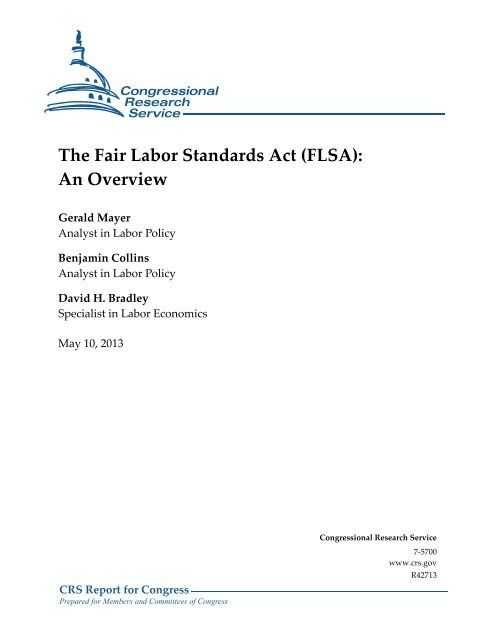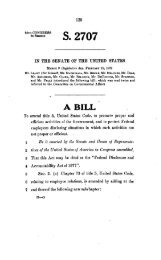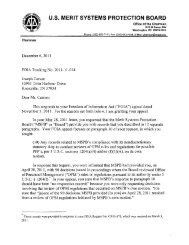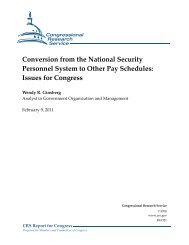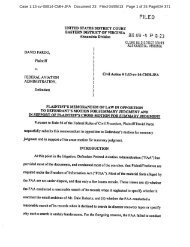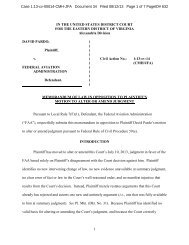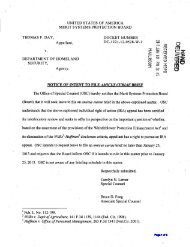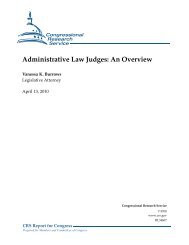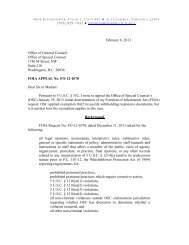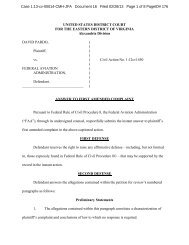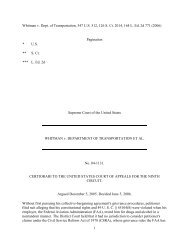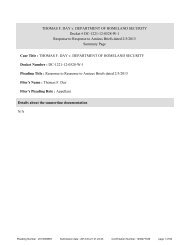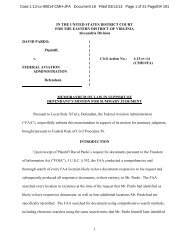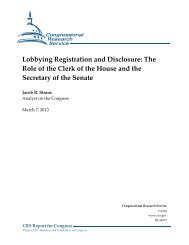The Fair Labor Standards Act (FLSA): An Overview - MSPB Watch
The Fair Labor Standards Act (FLSA): An Overview - MSPB Watch
The Fair Labor Standards Act (FLSA): An Overview - MSPB Watch
Create successful ePaper yourself
Turn your PDF publications into a flip-book with our unique Google optimized e-Paper software.
<strong>The</strong> <strong>Fair</strong> <strong>Labor</strong> <strong>Standards</strong> <strong>Act</strong> (<strong>FLSA</strong>): <strong>An</strong> <strong>Overview</strong>Summary<strong>The</strong> <strong>Fair</strong> <strong>Labor</strong> <strong>Standards</strong> <strong>Act</strong> (<strong>FLSA</strong>) provides workers with minimum wage, overtime pay, andchild labor protections. <strong>The</strong> <strong>FLSA</strong> covers most, but not all, private and public sector employees.In addition, certain employers and employees are exempt from coverage.Provisions of the <strong>FLSA</strong> that are of current interest to Congress include the basic minimum wage,subminimum wage rates, exemptions from overtime and the minimum wage for persons whoprovide companionship services, the exemption for employees in computer-related occupations,compensatory time (“comp time”) in lieu of overtime pay, and break time for nursing mothers.Basic Minimum Wage• <strong>The</strong> <strong>FLSA</strong> requires employers to pay covered, nonexempt employees at least theminimum wage. In 2007, the basic minimum wage was raised, in steps, from$5.15 to $7.25 an hour. <strong>The</strong> basic minimum wage was raised to $7.25 an houreffective July 24, 2009. As of January 1, 2013, 19 states and the District ofColumbia have minimum wage rates that are higher than the federal minimumwage rate.• Basic minimum wage rates in American Samoa and the Commonwealth of theNorthern Mariana Islands (CNMI) are lower than in the continental UnitedStates. In 2007, Congress passed the <strong>Fair</strong> Minimum Wage <strong>Act</strong> of 2007 (P.L. 110-28), which mandated annual increases of $0.50 an hour in the minimum wages ofAmerican Samoa and CNMI. In 2010, Congress temporarily suspended theseincreases. <strong>The</strong> minimum wage in CNMI increased by $0.50 an hour to $5.55 onSeptember 30, 2012. In July 2012, Congress delayed the increases in AmericanSamoa. <strong>The</strong> next minimum wage increases in American Samoa are scheduled forSeptember 30, 2015.Subminimum Wage Rates• Tipped employees may be paid less than the basic minimum wage, but their cashwage plus tips must equal at least the basic minimum wage of $7.25. Employersmay pay tipped workers $2.13 an hour in cash wages, provided the employeesreceive at least $5.12 an hour in tips. <strong>The</strong> latter amount is called a “tip credit.”• Employers may pay special minimum wages (SMWs) to workers withdisabilities. <strong>The</strong> purpose of the SMWs is to provide persons with disabilities theopportunity to work.Overtime• <strong>The</strong> <strong>FLSA</strong> requires employers to pay at least time-and-a-half to covered,nonexempt employees who work more than 40 hours in a week at a given job.• <strong>The</strong> <strong>FLSA</strong> allows covered, nonexempt state and local government employees toreceive compensatory time off (comp time) for hours worked over 40 in aworkweek. Comp time is time off with pay in lieu of overtime pay.Congressional Research Service
<strong>The</strong> <strong>Fair</strong> <strong>Labor</strong> <strong>Standards</strong> <strong>Act</strong> (<strong>FLSA</strong>): <strong>An</strong> <strong>Overview</strong>Exemptions• <strong>The</strong> <strong>FLSA</strong> exempts certain employers and employees from the minimum wage,overtime pay, or child labor standards of the act.• Certain employees in computer-related occupations are exempt from both theminimum wage and overtime standards of the <strong>FLSA</strong> if they meet an hourly wageor weekly salary test and a job duties test.Domestic service workers who provide companionship services in private homes are exempt fromboth the minimum wage and overtime requirements of the <strong>FLSA</strong>. Under regulations proposed bythe U.S. Department of <strong>Labor</strong> (DOL), minimum wage and overtime coverage would be extendedto companions employed by a third party. Overtime pay would be extended to live-in domesticservice workers employed by a third party.Congressional Research Service
<strong>The</strong> <strong>Fair</strong> <strong>Labor</strong> <strong>Standards</strong> <strong>Act</strong> (<strong>FLSA</strong>): <strong>An</strong> <strong>Overview</strong>ContentsWorking Families Flexibility <strong>Act</strong> of 2013 ....................................................................................... 1<strong>The</strong> <strong>Fair</strong> <strong>Labor</strong> <strong>Standards</strong> <strong>Act</strong> .......................................................................................................... 2Who Is Covered by the <strong>FLSA</strong>? ........................................................................................................ 3Relation of the <strong>FLSA</strong> to State Laws ................................................................................................ 4Minimum Wage Rates ...................................................................................................................... 4<strong>The</strong> Basic Minimum Wage ........................................................................................................ 5Tipped Workers.......................................................................................................................... 5Workers with Disabilities .......................................................................................................... 6New Hires Under the Age of 20 ................................................................................................ 6Full-Time Students .................................................................................................................... 7Student Learners ........................................................................................................................ 7Minimum Wage Rates in the Territories and Possessions of the United States ......................... 7Overtime .......................................................................................................................................... 8Comp Time in Lieu of Overtime Pay ........................................................................................ 8Break Time for Nursing Mothers............................................................................................... 9Exemptions from the Minimum Wage or Overtime <strong>Standards</strong> of the <strong>FLSA</strong> ................................... 9Executive, Administrative, and Professional Employees .......................................................... 9Outside Salespersons ............................................................................................................... 11Employees in Computer-Related Occupations ........................................................................ 12Domestic Service Employees .................................................................................................. 13Child <strong>Labor</strong> .................................................................................................................................... 15TablesTable A-1. Federal Minimum Wage Laws ..................................................................................... 21Table A-2. Minimum Wage Rates in the States and Other Jurisdictions, as of January 1,2013 ............................................................................................................................................ 22Table A-3. List of Acronyms .......................................................................................................... 23AppendixesAppendix. Major Amendments to the <strong>FLSA</strong>, Federal Minimum Wage Rates, and List ofAcronyms.................................................................................................................................... 18ContactsAuthor Contact Information........................................................................................................... 23Key Policy Staff ............................................................................................................................. 23Congressional Research Service
<strong>The</strong> <strong>Fair</strong> <strong>Labor</strong> <strong>Standards</strong> <strong>Act</strong> (<strong>FLSA</strong>): <strong>An</strong> <strong>Overview</strong>In 1937, the United States was recovering from the Great Depression. As part of the recoveryeffort, President Franklin D. Roosevelt endorsed a series of economic programs, known as theNew Deal, to help stimulate and rebuild the U.S. economy. <strong>The</strong> National Industrial Recovery<strong>Act</strong> (NIRA) was the major statute enacted to help achieve these goals. Although the NIRA waseventually found unconstitutional, many of its provisions appeared in later New Deal statutes,including in the <strong>Fair</strong> <strong>Labor</strong> <strong>Standards</strong> <strong>Act</strong> of 1938 (<strong>FLSA</strong>). 1Working Families Flexibility <strong>Act</strong> of 2013On April 9, 2013, Representative Martha Roby introduced H.R. 1406, the Working FamiliesFlexibility <strong>Act</strong> of 2013. <strong>The</strong> Subcommittee on Workforce Protections of the House Committee onEducation and the Workforce held a hearing on the bill on April 11, 2013. <strong>The</strong> full committeefavorably reported the legislation, as amended, to the House on April 30, 2013. <strong>The</strong> bill waspassed by the House by a vote of 223-204 on May 8, 2013. In the Senate, the measure wasreferred to the Committee on Health, Education, <strong>Labor</strong>, and Pensions (HELP).<strong>The</strong> <strong>FLSA</strong> requires employers to pay covered, nonexempt workers at least one-and-a-half timestheir regular hourly wage for hours worked in excess of 40 hours in a week. H.R. 1406 wouldamend the <strong>FLSA</strong> to allow private sector employers to offer employees compensatory time off(i.e., “comp” time) in place of overtime pay. Employees would receive at least one and a halfhours of paid comp time for each hour of overtime worked.<strong>The</strong> use of comp time would be optional for both employers and employees. Employers couldprovide comp time to employees under the provisions of a collective bargaining agreement orunder an agreement between an employer and employee. <strong>An</strong> employee could choose to accept orreject an offer of comp time. <strong>An</strong> employee may withdraw from a comp time agreement at anytime. <strong>An</strong> employer may withdraw from a comp time agreement with 30 days notice.Employees would be eligible for comp time if they have worked at least 1,000 hours for theiremployer in a period of continuous employment in the year before agreeing to or receiving comptime. Employees could accumulate up to 160 hours of comp time. <strong>An</strong> employee who requests touse comp time would be permitted to take time off within “a reasonable period” after making therequest if the use of comp time does not “unduly disrupt” the employer’s operations.Under the act, several circumstances would trigger the conversion of accrued comp time into amonetary payment:• At the end of each calendar year (or at the conclusion of another specified 12-month period), an employer must provide monetary compensation for any unusedcomp time.• <strong>An</strong> employee may request accrued comp time to be converted to monetarypayment at any time. <strong>The</strong> employer must comply with this request within 30days.• <strong>An</strong> employer, with 30 days notice, may convert any accrued comp time in excessof 80 hours to a monetary payment.1 Stephanie Fitzgerald, <strong>The</strong> New Deal: Rebuilding America (Minneapolis, MN: Compass Point Books, 2007), p. 77.Congressional Research Service 1
<strong>The</strong> <strong>Fair</strong> <strong>Labor</strong> <strong>Standards</strong> <strong>Act</strong> (<strong>FLSA</strong>): <strong>An</strong> <strong>Overview</strong>• If employment is terminated, either voluntarily or involuntarily, accrued comptime must be converted to a monetary payment.When comp time is converted to a monetary payment, the rate of compensation shall be thehigher of (1) the regular rate received by the employee when the comp time was earned or (2) thefinal regular rate received by the employee.Under the act, an employer that provides comp time could not intimidate, threaten, or coerce anyemployee to use comp time or interfere with an employee’s right to request or refuse comp time.<strong>An</strong> employer who violates this provision would be required to pay the employee for the amountof comp time earned plus an equal amount in damages.<strong>The</strong> amendments made to the <strong>FLSA</strong> by H.R. 1406 would expire five years after the date ofenactment of the act.<strong>The</strong> <strong>Fair</strong> <strong>Labor</strong> <strong>Standards</strong> <strong>Act</strong> 2<strong>The</strong> <strong>FLSA</strong> provides for a federal minimum wage, overtime pay, and child labor protections.Congress endorsed the act because its provisions were meant to both protect workers andstimulate the economy. <strong>The</strong> <strong>FLSA</strong> also created the Wage and Hour Division (WHD) within theDepartment of <strong>Labor</strong> (DOL) to administer and enforce the act. 3At the time of the act’s passage, Congress found that a few employers who paid substandardwages caused a decrease in wages within their respective industries, because other employerssought to compete in the marketplace with lower priced goods. 4 Congress also found that thesedecreased wages caused one-third of the U.S. population to be “ill-nourished, ill-clad, and illhoused.”5 To counter these conditions, in 1938 Congress established a minimum wage of $0.25 anhour, gradually increasing to $0.40 an hour in 1945. 6 Congress has since legislated severalincreases in the minimum wage. It now stands at $7.25 an hour.<strong>The</strong> <strong>FLSA</strong> also mandates a pay rate of one-and-one-half times an employee’s hourly wage forevery hour the employee works beyond a standard work week. When enacted, the <strong>FLSA</strong> requiredemployers to pay overtime for hours worked in excess of 44 hours in a week. 7 <strong>The</strong> 44-hourthreshold was lowered to 40 hours in 1940. <strong>The</strong> purpose of the overtime provision is to reduceunemployment by encouraging employers to hire more workers, rather than requiring currentemployees to work more than 40 hours per week and pay the premium overtime rate.Finally, under the <strong>FLSA</strong> Congress set certain conditions under which children could work. Notonly was oppressive child labor considered immoral, as children often worked at the cost of their2 This section of the report was written by Alexandra Hegji.3 Table A-3 in the Appendix provides a list of acronyms used in the report.4 U.S. Congress, House of Representatives Committee on <strong>Labor</strong>, <strong>Fair</strong> <strong>Labor</strong> <strong>Standards</strong> <strong>Act</strong>, Conference Report toAccompany S. 2475, 75 th Cong., 3 rd sess., June 11, 1938, Report No. 2738, p. 28.5 U.S. Congress, Senate Committee on Education and <strong>Labor</strong>, <strong>Fair</strong> <strong>Labor</strong> <strong>Standards</strong> <strong>Act</strong>, Report to Accompany S. 2475,75 th Cong., 1 st sess., July 6, 1937, Report No. 884, p. 1.6 <strong>Fair</strong> <strong>Labor</strong> <strong>Standards</strong> <strong>Act</strong> of 1938, ch. 676, §§6, 7, and 12, 52 Stat. 1060, at 1062-64, 1067.7 Ibid.Congressional Research Service 2
<strong>The</strong> <strong>Fair</strong> <strong>Labor</strong> <strong>Standards</strong> <strong>Act</strong> (<strong>FLSA</strong>): <strong>An</strong> <strong>Overview</strong>passed, and the President signed, the Insular Areas <strong>Act</strong> of 2011 (P.L. 112-149). <strong>The</strong> act delayedthe increases in the minimum wages in American Samoa for 2012, 2013, and 2014. <strong>The</strong> nextminimum wage increases in American Samoa are scheduled for September 30, 2015. <strong>The</strong>reafter,increases will be made every three years until they reach the federal minimum wage.In the mid-1970s, the United States and CNMI entered into a Covenant of Association. CNMIretained control over the minimum wage in the islands. However, as was the case with AmericanSamoa, P.L. 110-28 mandated that the minimum wage in CNMI be raised by $0.50 a year until itreached the same level as in the continental United States. However, P.L. 111-244 postponed thescheduled increase in the minimum wage for 2011. On September 30, 2012, the minimum wagein CNMI increased by $0.50 an hour to $5.55.OvertimeUnder Section 7, employers must pay covered workers at least one-and-a-half times their regularhourly wage for hours worked over 40 hours a week at a given job. Employers may choose to paymore than time-and-a-half for overtime or to pay overtime to employees who are exempt fromovertime under the <strong>FLSA</strong>.Under the <strong>FLSA</strong>, overtime pay applies to hours worked in excess of 40 in a workweek. Thus, thelaw allows some flexibility in work hours. For example, an employer could schedule four 10-hourworkdays in a workweek without asking employees to work overtime. Similarly, an employeewho works a five-day workweek could work four hours one day and nine hours the other fourdays and not work overtime. 30Comp Time in Lieu of Overtime Pay<strong>The</strong> <strong>FLSA</strong>, under Section 7(o), allows covered, nonexempt state and local government employeesto receive compensatory time off (“comp time”) for hours worked over 40 in a workweek. Comptime is time off with pay in lieu of overtime pay. <strong>An</strong> employer and employees must agree that theemployer will provide comp time. <strong>The</strong> agreement may be through a collective bargainingagreement or, if there is no such agreement, between the employer and individual employees.Comp time is calculated at a rate that is at least one-and-a-half times the number of overtimehours worked. In general, state and local government employees may accrue up to 240 hours ofcomp time. Law enforcement, fire protection, emergency response personnel, and employeesengaged in seasonal activities may accrue up to 480 hours of comp time. Instead of providingcomp time, an employer may pay an employee for any unused comp time. <strong>An</strong> employee must beallowed to use comp time on the date requested, unless doing so would “unduly disrupt” the(...continued)Territory of Guam, and for Other Purposes (P.L. 111-244).30 Some states have overtime laws that are more protective of employees than the <strong>FLSA</strong>; for example, overtime paymay be required if an employee works more than 8 or 12 hours in a day. See U.S. Department of <strong>Labor</strong>, Wage andHour Division, Wage and Hour Division (WHD) Minimum Wage Laws in the States, January 1, 2012,http://www.dol.gov/whd/minwage/america.htm.Congressional Research Service 8
<strong>The</strong> <strong>Fair</strong> <strong>Labor</strong> <strong>Standards</strong> <strong>Act</strong> (<strong>FLSA</strong>): <strong>An</strong> <strong>Overview</strong>operations of the agency. 31 Section 7(o) does not apply to state and local government employeeswho are exempt from overtime. 32Break Time for Nursing Mothers<strong>The</strong> Patient Protection and Affordable Care <strong>Act</strong> (PPACA, P.L. 111-148) added new Section 7(r) tothe <strong>FLSA</strong>. 33 Section 7 of the <strong>FLSA</strong> requires employers to pay at least time-and-a-half toemployees who work overtime. Section 13 of the <strong>FLSA</strong> provides several exemptions to theovertime requirements of Section 7. Thus, new Section 7(r) does not apply to employers oremployees who are exempt from overtime.Section 7(r) requires covered employers to provide break time for nursing mothers. Break timemust be provided for one year after the child’s birth. Employers must provide space, other than abathroom, that is shielded from view and free from intrusion from coworkers and the public. Onlyemployees who are not exempt from the <strong>FLSA</strong>’s overtime pay requirements are entitled to breaktimes to express milk. Employers with fewer than 50 employees are not subject to therequirement if compliance would impose an undue hardship on the employer. Employers are notrequired to compensate nursing mothers for breaks taken for the purpose of expressing milk.Exemptions from the Minimum Wage or Overtime<strong>Standards</strong> of the <strong>FLSA</strong>Most wage and salary workers are covered by the <strong>FLSA</strong>. However, under Section 13 of the actcertain employers and employees are exempt from coverage. <strong>The</strong>y may be exempt from either theminimum wage or overtime standards of the act, or both. This section considers some, but not all,of the current exemptions in Section 13. <strong>The</strong> focus is on those exemptions that have been thesubject of recent legislation, hearings, or oversight.Executive, Administrative, and Professional EmployeesWhen the <strong>Fair</strong> <strong>Labor</strong> <strong>Standards</strong> <strong>Act</strong> (P.L. 75-718) was enacted in 1938, Section 13(a)(1) providedan exemption, from both the minimum wage and overtime requirements of the act, for bona fideexecutive, administrative, and professional employees (the EAP exemption). 34 <strong>The</strong> act did notdefine the terms executive, administrative, or professional employee. Instead, the law stated thatthe terms would be defined in regulations issued by the Secretary of <strong>Labor</strong>. 3531 29 C.F.R. §§553.20-553.28.32 Federal employees can receive comp time under the Federal Employees Flexible and Compressed Work Schedules<strong>Act</strong> of 1982 (P.L. 97-221). Comp time may be used by both exempt and nonexempt employees. U.S. Office ofPersonnel Management, Compensatory Time Off, http://www.opm.gov/OCA/pay/html/comp.htm.33 Section 7(r) of the <strong>FLSA</strong> was added by Section 4207, “Reasonable Break Time for Nursing Mothers,” of PPACA.34 For more information on the exemption for executive, administrative, and professional employees, see CRS ReportRL32088, <strong>The</strong> <strong>Fair</strong> <strong>Labor</strong> <strong>Standards</strong> <strong>Act</strong>: A Historical Sketch of the Overtime Pay Requirements of Section 13(a)(1),by William G. Whittaker.35 Originally, the <strong>FLSA</strong> stated that regulations implementing the EAP exemption would be issued by the administratorof the newly created Wage and Hour Division (WHD) of DOL. <strong>The</strong> <strong>Fair</strong> <strong>Labor</strong> <strong>Standards</strong> Amendments of 1961 (P.L.(continued...)Congressional Research Service 9
<strong>The</strong> <strong>Fair</strong> <strong>Labor</strong> <strong>Standards</strong> <strong>Act</strong> (<strong>FLSA</strong>): <strong>An</strong> <strong>Overview</strong>Under current regulations, to qualify for the EAP exemption, employees must meet certain dutiestests and be paid a salary of at least $455 per week. 36 Job titles do not determine whether anemployee is exempt.To qualify for the exemption for executive employees, all of the following job duties tests mustbe met:• <strong>The</strong> employee’s primary duty “is management of the enterprise in which theemployee is employed or of a customarily recognized department or subdivisionthereof”;• <strong>The</strong> employee “customarily and regularly directs the work of two or more otheremployees”; and• <strong>The</strong> employee “has the authority to hire or fire other employees or whosesuggestions and recommendations as to the hiring, firing, advancement,promotion or any other change of status of other employees are given particularweight.” 37To qualify for the exemption for administrative employees, both of the following job duties testsmust be met:• <strong>The</strong> employee’s primary duty “is the performance of office or nonmanual workdirectly related to the management or general business operations of theemployer or the employer’s customers;” and• <strong>The</strong> employee’s primary duty “includes the exercise of discretion andindependent judgment with respect to matters of significance.” 38To qualify for the exemption for professional employees, the following job duties test must bemet:• <strong>The</strong> employee’s primary duty is the performance of work: “Requiring knowledgeof an advanced type in a field of science or learning customarily acquired by aprolonged course of specialized intellectual instruction;” or “Requiring invention,imagination, originality or talent in a recognized field of artistic or creativeendeavor.” 39(...continued)87-30) changed the authority to issue regulations from the administrator of the WHD to the Secretary of <strong>Labor</strong>.36 <strong>An</strong> employee whose total annual compensation is at least $100,000 is exempt if he or she “customarily andregularly” performs at least one of the job duties tests for executive, administrative, or professional employees. 29C.F.R. §541.601.Before 2004, under Section 13(a)(1), executive, administrative, or professional employees were exempt if they meteither a long or a short test. Under both tests, to be exempt, an employee had to meet both a salary test and a job dutiestest. U.S. Department of <strong>Labor</strong>, Wage and Hour Division, “Defining and Delimiting the Terms ‘<strong>An</strong>y EmployeeEmployed in a Bona Fide Executive, Administrative, Professional, or Local Retailing Capacity, or in the Capacity ofOutside Salesman,’” Federal Register, vol. 5, October 15, 1940, pp. 4077-4078.37 29 C.F.R. §541.100.38 29 C.F.R. §541.200.39 29 C.F.R. §541.300.Congressional Research Service 10
<strong>The</strong> <strong>Fair</strong> <strong>Labor</strong> <strong>Standards</strong> <strong>Act</strong> (<strong>FLSA</strong>): <strong>An</strong> <strong>Overview</strong>Periodically, DOL has modified the regulations that implement the EAP exemption. <strong>The</strong>regulations were last changed in 2004. <strong>The</strong> current minimum weekly salary of $455 is an issue inimplementing the exemption. Between changes in the threshold, weekly salaries may rise becauseof inflation or increases in labor productivity. Thus, unless the threshold is raised (eitherlegislatively or administratively), over time more employees become exempt from overtime pay.On the other hand, a higher threshold may make it more difficult for employers to administerovertime (i.e., because employers would have to keep track of hours worked for moreemployees).<strong>The</strong> job duties tests are a second issue in implementing the EAP exemption. For an employee tobe exempt, the employee’s job duties must meet the requirements for exemption. <strong>The</strong> tests arecomplex and can result in workers being misclassified (e.g., they may be classified as exemptwhen they should be nonexempt). For employers, a higher salary threshold may make it easier toadminister the job duties tests for exemption—because fewer employees would meet theminimum salary test.Outside SalespersonsOutside salespersons are also exempt under Section 13(a)(1) of the <strong>FLSA</strong>. Unlike executive,administrative, and professional employees, however, the $455 salary test does not apply tooutside salespersons.To qualify for the exemption for outside sales employees, an employee must meet both of thefollowing job duties tests:• <strong>The</strong> employee’s primary duty must be making sales (as defined in the <strong>FLSA</strong>), orobtaining orders or contracts for services or for the use of facilities for which aconsideration will be paid by the client or customer; 40 and• <strong>The</strong> employee must be customarily and regularly engaged away from theemployer’s place or places of business. 41<strong>An</strong> outside salesperson is someone who makes sales at the customer’s home or place of business.<strong>The</strong> person may work hours that are convenient for the customer. Also, the hours worked byoutside salespersons may be difficult for employers to monitor.One issue with the exemption for outside salespersons is whether a sale involves the actualtransfer of ownership of a company’s goods or services. In a June 2012 decision by the U.S.Supreme Court, the court ruled that pharmaceutical sales representatives (also called “detailers”)who encourage doctors to prescribe the use of a company’s prescription drugs are outsidesalespersons, even though the drugs can only be sold with a doctor’s prescription. 4240 Obtaining orders for “the use of facilities” includes selling advertising time on radio, television, or in newspapers,and soliciting freight for railroads or other transportation companies. U.S. Department of <strong>Labor</strong>, Wage and HourDivision, Exemption for Outside Sales Employees Under the <strong>Fair</strong> labor <strong>Standards</strong> <strong>Act</strong> (<strong>FLSA</strong>), http://www.dol.gov/whd/regs/compliance/fairpay/fs17f_outsidesales.pdf.41 29 C.F.R. §541.500.42 Christopher v. SmithKline Beecham Corp., No. 11-204, pp. 4-5, 14-15 (U.S. Supreme Court 2012).Congressional Research Service 11
<strong>The</strong> <strong>Fair</strong> <strong>Labor</strong> <strong>Standards</strong> <strong>Act</strong> (<strong>FLSA</strong>): <strong>An</strong> <strong>Overview</strong>Currently, regulations state that “Outside sales does not include sales made by mail, telephone orthe Internet unless such contact is used merely as an adjunct to personal calls.” 43 Somepolicymakers maintain that inside salespersons, whose primary duty is to make sales, should alsobe exempt.Employees in Computer-Related OccupationsIn 1990, Congress directed the Secretary of <strong>Labor</strong> to issue regulations that would exempt fromovertime and the minimum wage certain employees in computer-related occupations. 44 Before1990, computer employees could be exempt from <strong>FLSA</strong> coverage if they met the requirements ofthe EAP exemption. Regulations in effect in 1990 stated that the exemption for learnedprofessionals applied to employees who have acquired “knowledge of an advanced type in a fieldof science or learning customarily acquired by a prolonged course of specialized intellectualinstruction and study.” <strong>The</strong> regulations said that knowledge of an “advanced type” wasknowledge that generally could not be attained with only a high school degree. Rather, learnedprofessionals typically held an “academic degree.” <strong>The</strong> 1990 regulations went on to say that<strong>The</strong> question arises whether computer programmers and systems analysts in the dataprocessing field are included in the learned professions. At the present time there is too greata variation in standards and academic requirements to conclude that employees employed insuch occupations are a part of a true profession recognized as such by the academiccommunity with universally accepted standards for employment in the field. 45In 1990, Congress enacted legislation that directed the Secretary of <strong>Labor</strong> to issue regulations thatwould allow “computer systems analysts, computer programmers, software engineers, and othersimilarly skilled professional workers” to qualify as exempt executive, administrative, orprofessional employees under Section 13(a)(1) of the <strong>FLSA</strong>. <strong>The</strong> 1990 legislation also directedthe Secretary of <strong>Labor</strong> to apply the EAP exemption to employees in computer-related occupationsif they were paid on an hourly wage that was at least six-and-a-half times the basic federalminimum wage.In 1992, the U.S. Department of <strong>Labor</strong> (DOL) published final regulations that implemented the1990 legislation. <strong>The</strong> regulations treated computer employees as professional employees underthe EAP exemption. <strong>The</strong> regulations stated that the exemption applied to “highly skilled”computer employees. To be exempt as a professional employee, the 1992 regulations said that acomputer employee’s primary duty must consist of one or more of the following job duties:(1) <strong>The</strong> application of systems analysis techniques and procedures, including consulting withusers, to determine hardware, software, or system functional specifications;(2) <strong>The</strong> design, development, documentation, analysis, creation, testing, or modification ofcomputer systems or programs, including prototypes, based on and related to user or systemdesign specifications;43 29 C.F.R. §541.502.44 For more on the exemption for employees in computer-related occupations, see CRS Report R42141, Computer-Related Occupations Under the <strong>Fair</strong> <strong>Labor</strong> <strong>Standards</strong> <strong>Act</strong> (<strong>FLSA</strong>), by Gerald Mayer.45 29 C.F.R. §§541.302 (July 1, 1990, edition).Congressional Research Service 12
<strong>The</strong> <strong>Fair</strong> <strong>Labor</strong> <strong>Standards</strong> <strong>Act</strong> (<strong>FLSA</strong>): <strong>An</strong> <strong>Overview</strong>(3) <strong>The</strong> design, documentation, testing, creation or modification of computer programsrelated to machine operating systems; or(4) a combination of the aforementioned duties, the performance of which requires the samelevel of skills.Finally, the 1992 regulations stated that “While such employees commonly have a bachelor’s orhigher degree, no particular academic degree is required for this exemption.” 46When the final regulations implementing the 1990 legislation went into effect, the basic federalminimum wage was $4.25 an hour. Thus, computer employees who were paid by the hour wereexempt if they met the new job duties test and were paid at least $27.63 an hour (i.e., 6½ times$4.25).In 1996, Congress added Section 13(a)(17) to the <strong>FLSA</strong>. Section 13(a)(17) applies specifically toemployees in computer-related occupations. Under Section 13(a)(17), the minimum hourly wagefor computer professionals was fixed at $27.63 an hour. <strong>The</strong> exemption includes in statute muchof the language from the 1992 regulations that defined the primary duties of exempt computerprofessionals.In 2004, DOL issued new regulations that revised the salary and duties tests for the EAPexemption. <strong>The</strong> regulations also simplified the duties tests for computer professionals to reflectthe 1996 amendments to the <strong>FLSA</strong>. Under the 2004 regulations, computer professionals areexempt from the minimum wage and overtime standards of the <strong>FLSA</strong> if they meet the job dutiestest provided in regulations and, if they are paid an hourly wage, are paid at least $27.63 an houror, if they are paid a salary, are paid at least $455 a week. 47 <strong>The</strong> same duties tests apply to bothsalaried and hourly computer employees. 48Skilled computer workers are not necessarily exempt from the minimum wage or overtimerequirements of the <strong>FLSA</strong>. Employees engaged in the manufacture or repair of computerhardware are not exempt. Employees whose work is highly dependent on the use of computersand computer software programs (e.g., engineers, drafters and others skilled in computer-aideddesign software), but who are not primarily engaged in computer systems analysis andprogramming, are not exempt computer professionals. 49Domestic Service EmployeesWhen the <strong>FLSA</strong> was enacted in 1938, it did not cover domestic service employees. <strong>The</strong> <strong>Fair</strong><strong>Labor</strong> <strong>Standards</strong> Amendments of 1974 (P.L. 93-259) extended minimum wage and overtime46 U.S. Department of <strong>Labor</strong>, Wage and Hour Division, “<strong>Fair</strong> <strong>Labor</strong> <strong>Standards</strong> <strong>Act</strong>: Computer-Related Occupations;Exemption from Minimum Wage and Overtime Compensation Requirements; Final Rule,” Federal Register, vol. 57,October 9, 1992, p. 46744.47 <strong>The</strong> minimum weekly salary of $455 may be paid in periods longer than a week (e.g., $910 biweekly or $1,971.66 amonth). 29 C.F.R. §541.600(b).48 29 C.F.R. §541.400(b).49 29 C.F.R. §541.401.Congressional Research Service 13
<strong>The</strong> <strong>Fair</strong> <strong>Labor</strong> <strong>Standards</strong> <strong>Act</strong> (<strong>FLSA</strong>): <strong>An</strong> <strong>Overview</strong>coverage to include domestic service workers who are employed in private households. 50Domestic service workers include housekeepers, cooks, full-time babysitters, and others. 51In addition to extending minimum wage and overtime coverage to domestic service employees,the 1974 amendments added two exemptions that affect two types of domestic service workers:domestic service workers who provide companionship services and live-in domestic serviceworkers. Under Section 13(a)(15) of the <strong>FLSA</strong>, domestic service workers who providecompanionship services in private homes are exempt from both the minimum wage and overtimestandards of the act. Section 13(b)(21) of the act exempts from overtime, but not the minimumwage, domestic service workers who provide live-in domestic services.On December 27, 2011, DOL issued a Notice of Proposed Rulemaking (NPRM) that wouldchange the definition of companionship services. 52 Under current regulations:• Companionship services are defined as “those services which provide fellowship,care, and protection for a person who, because of advanced age or physical ormental infirmity, cannot care for his or her own needs.”• Companionship services may include household work related to the care of theaged or infirmed individual, such as preparing meals, bed making, or washingclothes. General household work (such as housecleaning) may also be included incompanionship services. However, general household work must be “incidental”to providing companionship services. Current regulations define incidental as20% or less of the total hours worked.• Companionship services do not include services performed by trained personnel,such as registered or practical nurses. 5350 <strong>The</strong> 1974 amendments added Sections 6(f) and 7(l) to the <strong>FLSA</strong>. Section 6(f) extended minimum wage coverage todomestic service employees. Section 6(f) states that<strong>An</strong>y employee (1) who in any workweek is employed in domestic service in a household shall bepaid wages at a rate not less than the wage rate in effect under subsection (b) of this section unlesssuch employee’s compensation for such service would not because of section 209(a)(6) of theSocial Security <strong>Act</strong> (42 U.S.C. 409(a)(6)) constitute wages for the purposes of title II of such <strong>Act</strong>(42 U.S.C. 401 et seq.), [i.e., the employee’s pay must be wages for purposes of Social Security] or(2) who in any workweek (A) is employed in domestic service in one or more households, and (B)is so employed for more than 8 hours in the aggregate, shall be paid wages for such employment insuch workweek at a rate not less than the wage rate in effect under subsection (b) of this section.[Note: Section 6(b) requires employers to pay employees at least the minimum wage rate requiredin Section 6(a) of the <strong>FLSA</strong>.]Section 7(l) extended overtime coverage to domestic service employees. Section 7(l) states thatNo employer shall employ any employee in domestic service in one or more households for aworkweek longer than forty hours unless such employee receives compensation for suchemployment in accordance with subsection (a) of this section. [Note: Section 7(a) requiresemployers to pay covered employees at least one-and-a-half times their regular rate of pay forovertime.]51 DOL, Coverage Under the <strong>Fair</strong> <strong>Labor</strong> <strong>Standards</strong> <strong>Act</strong>.52 U.S. Department of <strong>Labor</strong>, Wage and Hour Division, “Application of the <strong>Fair</strong> <strong>Labor</strong> <strong>Standards</strong> <strong>Act</strong> to DomesticService,” Federal Register, vol. 76, December 27, 2011, pp. 81190-81244. (Hereafter cited as DOL, Application of the<strong>Fair</strong> <strong>Labor</strong> <strong>Standards</strong> <strong>Act</strong> to Domestic Service.) DOL twice extended the comment period on the proposed rule.Comments were due on or before March 21, 2012. U.S. Department of <strong>Labor</strong>, Wage and Hour Division, “Applicationof the <strong>Fair</strong> <strong>Labor</strong> <strong>Standards</strong> <strong>Act</strong> to Domestic Service,” Federal Register, vol. 77, March 13, 2012, pp. 14688-14689.53 29 C.F.R. §552.6. DOL, Application of the <strong>Fair</strong> <strong>Labor</strong> <strong>Standards</strong> <strong>Act</strong> to Domestic Service, p. 81195. A registered(continued...)Congressional Research Service 14
<strong>The</strong> <strong>Fair</strong> <strong>Labor</strong> <strong>Standards</strong> <strong>Act</strong> (<strong>FLSA</strong>): <strong>An</strong> <strong>Overview</strong><strong>The</strong> NPRM would narrow the exemption for companionship services. Under the proposed rule:• <strong>The</strong> definition of companionship services would be limited to fellowship andprotection (eliminating the reference to “care”). Fellowship and protection mayinclude activities such as conversation, reading, watching television, going forwalks, or visiting with friends of the person being cared for. A companion mayalso help the person use a wheelchair or walker and help the person move fromone area of the home to another.• Companions could spend up to 20% of total hours worked on incidental “intimatepersonal care” services. <strong>The</strong>se services must be performed in conjunction withproviding companionship services and may include occasional feeding, dressing,bathing, or grooming. A companion may occasionally drive the person to runerrands or to appointments or social events. Incidental intimate personal careservices would not include household work that benefits other members of thehousehold, such as housekeeping, making meals, or doing laundry.• Companionship services would not include medical care provided by personswith specialized training. 54<strong>The</strong> proposed rule would also extend minimum wage and overtime coverage to companionsemployed by a third party employer, and extend overtime coverage to live-in domestic workersemployed by a third party. <strong>The</strong> exemption for companions would continue to apply tocompanions employed directly by an individual or family (provided the companions meet thenew definition of companionship services). Live-in domestic workers employed directly byindividuals or families would still be exempt from overtime. 55DOL’s target date for issuing a final rule is April 2013. 56Child <strong>Labor</strong><strong>The</strong> <strong>FLSA</strong> sets minimum age requirements for youth employed outside of school hours inagricultural and nonagricultural occupations. In nonagricultural occupations, the act sets a generalminimum age for employment of 16. In agricultural occupations, the general minimum age towork is 14. 57<strong>The</strong> <strong>FLSA</strong> includes a number of exceptions to the general minimum age requirements of the act.Under a parental exemption, a child of any age may be employed by his or her parent (or personstanding in the place of a parent) in any occupation in a business, including a farm, owned or(...continued)nurse may be exempt from the minimum wage and overtime standards of the <strong>FLSA</strong> as a professional employee undersection 13(a)(1) of the act.54 DOL, Application of the <strong>Fair</strong> <strong>Labor</strong> <strong>Standards</strong> <strong>Act</strong> to Domestic Service, pp. 81193-81195, 81244.55 Ibid., pp. 81195-81196.56 Office of Information and Regulatory Affairs, Office of Management and Budget, Application of the <strong>Fair</strong> <strong>Labor</strong><strong>Standards</strong> <strong>Act</strong> to Domestic Service, RIN1235-AA05, http://www.reginfo.gov/.57 For more information on child labor, see CRS Report RL31501, Child <strong>Labor</strong> in America: History, Policy, andLegislative Issues, by Gerald Mayer.Congressional Research Service 15
<strong>The</strong> <strong>Fair</strong> <strong>Labor</strong> <strong>Standards</strong> <strong>Act</strong> (<strong>FLSA</strong>): <strong>An</strong> <strong>Overview</strong>operated by the parent. But, youth under 18 cannot be employed in mining or manufacturing,including in a business owned or operated by a parent. 58Youth under a certain age cannot work in occupations determined by the Secretary of <strong>Labor</strong> to behazardous to minors. <strong>The</strong> minimum age to work in hazardous occupations in nonagriculturaloccupations is 18. In agricultural occupations, the minimum age is 16.<strong>The</strong> <strong>FLSA</strong> also provides exemptions from the limits on employment in hazardous occupations. Inagriculture, youth between the ages of 14 and 15 may work in certain hazardous occupations ifthey are student learners. 59 Minors ages 14 and 15 can operate tractors or other machinery if theyhold a certificate of training from a 4-H or vocational agriculture training program. <strong>The</strong>restrictions on employment in hazardous occupations in agriculture do not apply to youthemployed on farms owned or operated by a parent.Youth ages 12 and 13 can work in agriculture with the written consent of their parents on a farmwhere a parent (or person standing in the place of a parent) is also employed.Youth who are covered by the <strong>FLSA</strong> and are not exempt must be paid at least the applicablefederal or state minimum wage. However, employees in agriculture are exempt from the overtimerequirements of the <strong>FLSA</strong>. 60On September 2, 2011, DOL issued a proposed rule to change the regulations that implement thechild labor provisions in agriculture. In the proposed rule, DOL said that “None of the revisionsproposed in this NPRM in any way change or diminish the statutory child labor parentalexemption in agricultural employment” in the <strong>FLSA</strong>. 61 Nevertheless, in response to concernsabout the potential effects of the proposed rule on the parental exemption, DOL announced, onFebruary 1, 2012, that it was going to reconsider the part of the rule dealing with theinterpretation of the parental exemption. DOL said that instead of applying the parentalexemption to farms that are “wholly” owned by the parent (or person standing in place of aparent) the exemption would apply to farms that are “substantially” owned by the parent. Thus,the parental exemption would apply to farms where the parent is a part owner of the farm, apartner in a partnership, or an officer of a corporation that owns the farm if the parent holds asubstantial ownership interest in the partnership or corporation. 6258 Information on the age limits for youth employment are from U. S. Department of <strong>Labor</strong>, Wage and Hour Division,Child <strong>Labor</strong> Requirements in Agricultural Occupations Under the <strong>Fair</strong> <strong>Labor</strong> <strong>Standards</strong> <strong>Act</strong>, Child <strong>Labor</strong> Bulletin 102,available at http://www.dol.gov/whd/regs/compliance/childlabor102.pdf; and U. S. Department of <strong>Labor</strong>, Wage andHour Division, Child <strong>Labor</strong> Provisions in Nonagricultural Occupations Under the <strong>Fair</strong> <strong>Labor</strong> <strong>Standards</strong> <strong>Act</strong>, Child<strong>Labor</strong> Bulletin 101, available at http://www.dol.gov/whd/regs/compliance/childlabor101.pdf.59 A student learner is someone who is enrolled in a vocational education program in agriculture under a writtenagreement that, among other things, ensures that the work of the student is incidental to the training.60 29 U.S.C. 213(b)(12). Employees on small farms are exempt from both the minimum wage and overtimerequirements of the <strong>FLSA</strong>. A farmer who did not employ more than 500 “man days” of labor in any calendar quarter inthe preceding calendar year is exempt from the minimum wage and overtime requirements of the act. A “man day” isany day in which an employee performed agricultural work for at least one hour.61 U.S. Department of <strong>Labor</strong>, Wage and Hour Division, “Child <strong>Labor</strong> Regulations, Orders and Statements ofInterpretation; Child <strong>Labor</strong> Violations—Civil Money Penalties,” Federal Register, vol. 76, September 2, 2011,available at http://www.gpo.gov/fdsys/pkg/FR-2011-09-02/pdf/2011-21924.pdf, p. 54841.62 U.S. Department of <strong>Labor</strong>, Wage and Hour Division, U.S. <strong>Labor</strong> Department to Re-Propose ‘Parental Exemption’ ofChild <strong>Labor</strong> in Agriculture Rule, February 1, 2012, http://www.dol.gov/opa/media/press/whd/WHD20120203.htm.Congressional Research Service 16
<strong>The</strong> <strong>Fair</strong> <strong>Labor</strong> <strong>Standards</strong> <strong>Act</strong> (<strong>FLSA</strong>): <strong>An</strong> <strong>Overview</strong>On April 26, 2012, DOL announced that it was withdrawing the proposed rule. DOL stated that“<strong>The</strong> decision to withdraw this rule—including provisions to define the ‘parental exemption’—was made in response to thousands of comments expressing concerns about the effect of theproposed rules on small family-owned farms.” DOL also stated that the regulation will not bepursued for the duration of the Obama Administration. 6363 U.S. Department of <strong>Labor</strong>, Wage and Hour Division, <strong>Labor</strong> Department Statement on Withdrawal of Proposed RuleDealing With Children Who Work in Agricultural Vocations, http://www.dol.gov/opa/media/press/whd/WHD20120826.htm.Congressional Research Service 17
<strong>The</strong> <strong>Fair</strong> <strong>Labor</strong> <strong>Standards</strong> <strong>Act</strong> (<strong>FLSA</strong>): <strong>An</strong> <strong>Overview</strong>Appendix. Major Amendments to the <strong>FLSA</strong>, FederalMinimum Wage Rates, and List of AcronymsThis appendix briefly describes major amendments to the <strong>Fair</strong> <strong>Labor</strong> <strong>Standards</strong> <strong>Act</strong> (<strong>FLSA</strong>).Table A-1 shows the history of legislated changes in the basic federal minimum wage. Table A-2shows the minimum wage rates in the states and other jurisdictions as of January 1, 2012. TableA-3 provides a list of acronyms used in the report.Major Amendments to the <strong>FLSA</strong><strong>The</strong> <strong>FLSA</strong> has been amended several times since 1938. 64 <strong>The</strong> amendments generally expandedcoverage of the act, created subminimum wage rates, and increased the basic minimum wage.1947 AmendmentsIn 1947, Congress passed the Portal-to-Portal <strong>Act</strong>. <strong>The</strong> act addressed issues arising out of severalcourt cases. First, Congress addressed the practical definition of hours worked, for which anemployee must be paid. Congress excluded from hours worked time spent traveling to and fromwork. Congress also stated that some “preliminary” and “postliminary” activities performedbefore or after the workday are not hours worked. 65 However, workers could be compensated forsuch activities if the worker and employer agreed to such employment terms or if compensationfor the activities was customary in the place of employment. 66<strong>The</strong> 1947 amendments also allow parties to settle a worker’s minimum wage or overtime claim if“there exists a bona fide dispute as to the amount payable.” 67 However, parties cannot agree to asettlement that would result in a wage less than the minimum wage or payment of less than timeand-a-halffor overtime. 68Additionally, in the 1947 amendments Congress prohibited class action suits under the statute,unless the Secretary of <strong>Labor</strong> filed the suit as the representative of workers. It also limited theavailability of compensation recovered in a class action suit only to those employees whoaffirmatively agreed to be a part of the suit. 69 Finally, the amendments set a two-year statute oflimitation (time limit) in which a worker could file a claim. 7064 <strong>The</strong> review of major amendments to the <strong>FLSA</strong> was written by Alexandra Hegji.65 For instance, absent an employer-worker agreement or workplace custom, employers may not be required to payworkers minimum wage or overtime pay for the time workers spend changing clothes at the beginning and end of shiftswhile on work premises. See, for example, Genuth v. National Biscuit Co., 81 F. Supp. 213 (S.D.N.Y. 1948).66 29 U.S.C. §252.67 29 U.S.C. §253(a).68 Ibid.69 29 U.S.C. §216.70 29 U.S.C. §255.Congressional Research Service 18
<strong>The</strong> <strong>Fair</strong> <strong>Labor</strong> <strong>Standards</strong> <strong>Act</strong> (<strong>FLSA</strong>): <strong>An</strong> <strong>Overview</strong>1961 and 1966 AmendmentsIn 1961, Congress amended <strong>FLSA</strong> exemptions such that employers of retail workers inenterprises with annual sales in excess of $1 million were required to pay minimum wage andovertime rates. 71In 1966, Congress expanded coverage of the <strong>FLSA</strong> to include workers employed in any enterprisewith annual sales of at least $250,000 and employees of all businesses engaged in construction,repair, laundering, and cleaning services. Additionally, for the first time, <strong>FLSA</strong> coverage wasextended to employees of hospitals, elementary and secondary schools, and institutions of highereducation. 72 <strong>The</strong> 1966 amendments also added a “tip credit,” which allowed employers to includea portion of an employee’s tips as part of the minimum wage. 73 Finally, the 1966 amendmentsrestricted the employment of youth under the age of 16 in agriculture in occupations found by theSecretary of <strong>Labor</strong> to be particularly hazardous, except when the employee is employed by aparent on a farm owned or operated by the parent. 741974 Amendments<strong>The</strong> 1974 <strong>FLSA</strong> amendments extended coverage to most federal, state, and local governmentemployees. However, fire protection and law enforcement employees (including securitypersonnel in correctional institutions) of public agencies were given special treatment, such as acomplete exemption from overtime for agencies that employ fewer than five employees in fireprotection or law enforcement and a partial exemption from overtime for fire protection and lawenforcement employees who work from 7 to 28 consecutive days. 751985 AmendmentsIn 1985, to ease the financial burden on state and local governments of paying overtime tosignificant numbers of employees, Congress amended the <strong>FLSA</strong> to allow public employers tooffer their workers compensatory time off from work in lieu of overtime pay. 761989 AmendmentsIn 1989, <strong>FLSA</strong> coverage was extended to enterprises with annual sales of at least $500,000. <strong>The</strong>amendments also repealed the retail exemption, under which employees of almost all small retailenterprises were exempt from the minimum wage and overtime rates.71 <strong>Fair</strong> <strong>Labor</strong> <strong>Standards</strong> Amendments of 1961, P.L. 87-30.72 1966 U.S.C.C.A.N. §3003, 3008.73 29 U.S.C. §203(m).74 U.S. House of Representatives, <strong>Fair</strong> <strong>Labor</strong> <strong>Standards</strong> Amendments of 1966, Conference Report to Accompany H.R.13712, 89 th Cong., 2 nd sess., Report No. 2004, September 6, 1966, p. 18.75 <strong>Fair</strong> <strong>Labor</strong> <strong>Standards</strong> Amendments, 1974, P.L. 93-259.76 <strong>Fair</strong> <strong>Labor</strong> <strong>Standards</strong> Amendments of 1985, P.L. 99-150.Congressional Research Service 19
<strong>The</strong> <strong>Fair</strong> <strong>Labor</strong> <strong>Standards</strong> <strong>Act</strong> (<strong>FLSA</strong>): <strong>An</strong> <strong>Overview</strong><strong>The</strong> 1996 Small Business Job Protection <strong>Act</strong>In 1996, Congress exempted certain computer professionals from minimum wage and overtimeregulations. 77 <strong>The</strong> 1996 amendments also brought within the <strong>FLSA</strong>’s minimum wage coverage allgovernment employees employed as of April 1, 1996.<strong>The</strong> 2007 Increases in the Basic Minimum WageOn May 25, 2007, President George W. Bush signed into law a supplemental appropriations billtitled the “U.S. Troop Readiness, Veterans’ Care, Katrina Recovery, and Iraq AccountabilityAppropriations <strong>Act</strong>, 2007” (P.L. 110-28). Title VIII of the act, “<strong>Fair</strong> Minimum Wage and TaxRelief,” increased the basic federal minimum wage from $5.15 to $5.85 an hour effective July2007, from $5.85 to $6.55 an hour effective July 2008, and from $6.55 to $7.25 an hour effectiveJuly 2009.<strong>The</strong> Equal Pay <strong>Act</strong><strong>The</strong> Equal Pay <strong>Act</strong> (EPA), although commonly referred to on its own, was an amendment to the<strong>FLSA</strong>. <strong>The</strong> EPA was enacted in 1963 and prohibits gender-based pay discrimination. 78Break Time for Nursing Mothers<strong>The</strong> 2010 Patient Protection and Affordable Care <strong>Act</strong> (PPACA) amended the <strong>FLSA</strong> to requirecovered employers to provide reasonable break time to nonexempt employees to express breastmilk for a nursing child.77 29 U.S.C. §213(a)(17).78 29 U.S.C. §§206-209.Congressional Research Service 20
<strong>The</strong> <strong>Fair</strong> <strong>Labor</strong> <strong>Standards</strong> <strong>Act</strong> (<strong>FLSA</strong>): <strong>An</strong> <strong>Overview</strong>Table A-1. Federal Minimum Wage LawsPublic Law and Date Enacted Wage Rate Effective Date of Wage RateP.L. 75-718, enacted June 25, 1938 $0.250.300.40October 1938October 1939October 1945P.L. 81-393, enacted October 26, 1949 0.75 January 1950P.L. 84-381, enacted August 12, 1955 1.00 March 1956P.L. 87-30, enacted May 5, 1961 1.151.25P.L. 89-601, enacted September 23, 1966 1.401.60P.L. 93-259, enacted April 8, 1974 2.002.102.30P.L. 95-151, enacted November 1, 1977 2.652.903.103.35P.L. 101-157, enacted November 17, 1989 3.804.25P.L. 104-188, enacted August 20, 1996 4.755.15P.L. 110-28, enacted May 25, 2007 5.856.557.25September 1961September 1963February 1967February 1968May 1974January 1975January 1976January 1978January 1979January 1980January 1981April 1990April 1991October 1996September 1997July 2007July 2008July 2009Source: http://www.crs.gov/pages/Reports.aspx?PRODCODE=RL33971CRS Report RL33791, PossibleIndexation of the Federal Minimum Wage: Evolution of Legislative <strong>Act</strong>ivity, by William G. Whittaker.Congressional Research Service 21
<strong>The</strong> <strong>Fair</strong> <strong>Labor</strong> <strong>Standards</strong> <strong>Act</strong> (<strong>FLSA</strong>): <strong>An</strong> <strong>Overview</strong>Table A-2. Minimum Wage Rates in the States and Other Jurisdictions,as of January 1, 2013Jurisdictions (20) With Minimum Wage Rates Higher Than the Federal Minimum WageAlaska ($7.75) Illinois ($8.25) New Mexico ($7.50)Arizona ($7.80) Maine ($7.50) Ohio ($7.85)California ($8.00) Massachusetts ($8.00) Oregon ($8.95)Colorado ($7.78) Michigan ($7.40) Rhode Island ($7.75)Connecticut ($8.25) Missouri ($7.35) Vermont ($8.60)District of Columbia ($8.25) Montana ($7.80) Washington ($9.19)Florida ($7.79) Nevada ($8.25)Jurisdictions (24) With Minimum Wage Rates the Same as the Federal Minimum Wage ($7.25)Delaware Maryland PennsylvaniaGuam Nebraska South DakotaHawaii New Hampshire TexasIdaho New Jersey UtahIndiana New York U.S. Virgin IslandsIowa North Carolina VirginiaKansas North Dakota West VirginiaKentucky Oklahoma WisconsinJurisdictions (7) With Minimum Wage Rates Less Than the Federal Minimum Wage aAmerican Samoa ($4.18-$5.59) b Georgia ($5.15) Puerto Rico ($4.10)Arkansas ($6.25) Minnesota ($6.15) Wyoming ($5.15)Commonwealth of the NorthernMariana Islands (CNMI) ($5.55) bJurisdictions (5) With No State Minimum Wage Requirement aAlabama Mississippi TennesseeLouisianaSouth CarolinaSource: U.S. Department of <strong>Labor</strong>, Wage and Hour Division, Changes in Basic Minimum Wages in NonfarmEmployment Under State Law: Selected Years 1968 To 2013, http://www.dol.gov/whd/state/stateMinWageHis.htm#.UORh87RHDAk. U.S. Department of <strong>Labor</strong>, Wage and Hour Division, Employee RightsUnder the <strong>Fair</strong> <strong>Labor</strong> <strong>Standards</strong> <strong>Act</strong>, http://www.dol.gov/whd/regs/compliance/posters/cnmi.pdf.Notes: Coverage patterns vary from one jurisdiction to another. <strong>The</strong> table shows the highest wage applicableunder current law.a. In states with a minimum wage that is lower than the federal minimum wage or with no minimum wage,state law applies to workers who are not covered by the <strong>FLSA</strong>.b. On September 30, 2012, the minimum wage in CNMI increased by $0.50 an hour to $5.55. In AmericanSamoa, the next wage increases are scheduled for September 30, 2015. <strong>The</strong> rates will then rise every threeyears until they reach the federal minimum wage.Congressional Research Service 22
<strong>The</strong> <strong>Fair</strong> <strong>Labor</strong> <strong>Standards</strong> <strong>Act</strong> (<strong>FLSA</strong>): <strong>An</strong> <strong>Overview</strong>Table A-3. List of AcronymsAcronymBLSCNMICPI-UDOLEAPEPA<strong>FLSA</strong>NIRANPRMPPACASICSMWSWEPWHDDescriptionBureau of <strong>Labor</strong> Statistics of the U.S. Department of <strong>Labor</strong>Commonwealth of the Northern Mariana IslandsConsumer Price Index for All Urban ConsumersU.S. Department of <strong>Labor</strong>Executive, administrative, and professional employeesEqual Pay <strong>Act</strong><strong>Fair</strong> <strong>Labor</strong> <strong>Standards</strong> <strong>Act</strong>National Industrial Recovery <strong>Act</strong>Notice of Proposed Rule MakingPatient Protection and Affordable Care <strong>Act</strong>Special Industrial CommitteesSpecial minimum wage rates for persons with disabilitiesSchool Work Experience ProgramWage and Hour Division of the U.S. Department of <strong>Labor</strong>Author Contact InformationGerald Mayer<strong>An</strong>alyst in <strong>Labor</strong> Policygmayer@crs.loc.gov, 7-7815Benjamin Collins<strong>An</strong>alyst in <strong>Labor</strong> Policybcollins@crs.loc.gov, 7-7382David H. BradleySpecialist in <strong>Labor</strong> Economicsdbradley@crs.loc.gov, 7-7352Key Policy StaffArea of Expertise Name Phone E-mail<strong>FLSA</strong> minimum wages David Bradley 7-7352 dbradley@crs.loc.govOvertime pay Benjamin Collins 7-7382 bcollins@crs.loc.govInformation Research Specialist Paul Janov 7-6615 mpjanov@crs.loc.govOvertime pay and child labor Gerald Mayer 7-7815 gmayer@crs.loc.govInformation Research Specialist Abigail Rudman 7-9515 arudman@crs.loc.govLegal issues Jon Shimabukuro 7-7990 jshimabukuro@crs.loc.govCongressional Research Service 23


